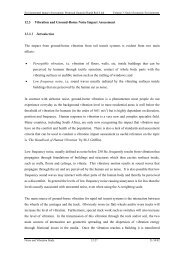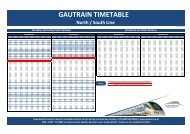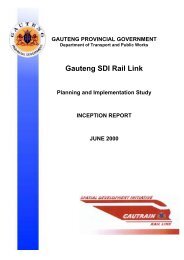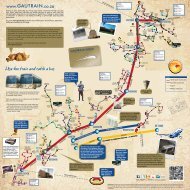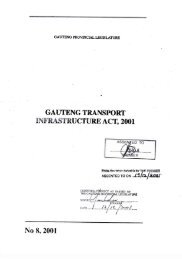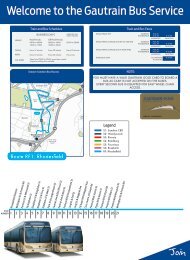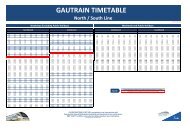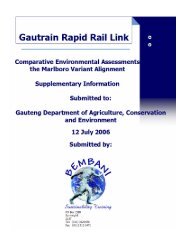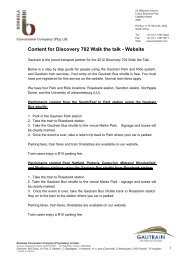environmental impact assessment for the proposed gautrain rapid ...
environmental impact assessment for the proposed gautrain rapid ...
environmental impact assessment for the proposed gautrain rapid ...
You also want an ePaper? Increase the reach of your titles
YUMPU automatically turns print PDFs into web optimized ePapers that Google loves.
Environmental Impact Assessment: Proposed Gautrain Rapid Rail Link<br />
All commuter (or general passenger) services will be operated as ‘premium’ services, with<br />
provision <strong>for</strong> ‘premium plus’ services. The airline passenger service will be a ‘premium plus’<br />
service. A new attractive image is required <strong>for</strong> <strong>the</strong> Gautrain as a realistic transport alternative to <strong>the</strong><br />
private car. The services must be safe, com<strong>for</strong>table and predictable, especially <strong>for</strong> airport passenger<br />
users. Decentralised flight check-in facilities are anticipated at <strong>the</strong> <strong>proposed</strong> Sandton Station <strong>for</strong> <strong>the</strong><br />
airport service, with space <strong>for</strong> luggage on <strong>the</strong> train.<br />
Train and Rail Infrastructure<br />
The Gautrain will be powered by electricity. Electrical power is an <strong>environmental</strong>ly clean <strong>for</strong>m of<br />
traction and electric trains are quieter than diesel trains. Power <strong>for</strong> <strong>the</strong> train will be supplied by<br />
Eskom, with a municipal electrical supply to <strong>the</strong> train stations. Electric Multiple Units (EMUs) will<br />
be used <strong>for</strong> <strong>the</strong> train, with power distributed throughout <strong>the</strong> train via motorised axles. Cooling fans<br />
will be used to cool <strong>the</strong> motors and <strong>for</strong> <strong>the</strong> air-conditioning system.<br />
A driver’s cab will be located at ei<strong>the</strong>r end of <strong>the</strong> train set. The trains will be coupled in multiple<br />
configurations of 3 or 4-car units, with seating space <strong>for</strong> 80 passengers per car and standing space<br />
<strong>for</strong> 20 passengers per car on <strong>the</strong> commuter services, and seating space <strong>for</strong> 50 passengers per car on<br />
<strong>the</strong> airline passenger service.<br />
To serve <strong>the</strong> expected number of passengers using <strong>the</strong> system in its early years, approximately<br />
20 – 25 train sets will be required, with additional rolling stock being procured during <strong>the</strong> life of <strong>the</strong><br />
project to serve growing passenger numbers. The rolling stock will be fitted with axle-mounted<br />
disc brakes and not <strong>the</strong> typical cast iron brake shoes used on Metrorail car units.<br />
Trains in South Africa are operated on rail tracks using <strong>the</strong> Cape Gauge (1065 mm width).<br />
However, most <strong>rapid</strong> rail systems in <strong>the</strong> world use <strong>the</strong> international Standard Gauge<br />
(1435 mm width), which is preferable because it can accommodate regular and safe train services<br />
<strong>for</strong> speeds up to 160 km/hr and higher (130 km/hr is considered to be <strong>the</strong> maximum practical and<br />
safe speed attainable on <strong>the</strong> Cape Gauge). As a stand-alone <strong>rapid</strong> rail system, <strong>the</strong> Gautrain will be<br />
constructed on <strong>the</strong> Standard Gauge. Train station plat<strong>for</strong>ms will be located on straight-line sections,<br />
approximately 250-300 m in length to accommodate longer train sets when <strong>the</strong> system is operating<br />
at capacity.<br />
Since <strong>the</strong> <strong>proposed</strong> rail alignment runs through or near built-up areas, it was considered important to<br />
develop a rail reserve as narrow as practically possible. A cross-section of a typical rail reserve of<br />
30 m allows <strong>for</strong> two rail tracks (one line in each direction), and can also accommodate a service<br />
road running in parallel to <strong>the</strong> rail line.<br />
Executive Summary 4 21/10/02



